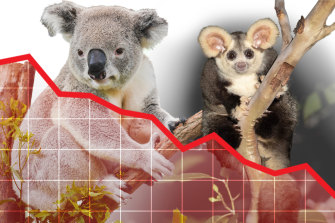The State of the Environment report makes for disturbing, although unsurprising, reading. Almost every indicator used to assess the health of Australia’s land and water paints the picture of a poor and declining country: an extinction crisis, limited access to drinking water, increasing weather extremes caused by climate change and insufficient funding to address the problems.
The 2000-page report is consistent with previous reports. The question we must now ask is where to from here?
The koala and the greater glider could both become extinct without drastic action to repair Australia’s environment.Credit:Composite: Kathleen Adele
Reform the law
At the heart of the problem is the failure of the law we rely upon to protect our natural world, the Environment Protection and Biodiversity Conservation Act of 1999, to do its job.
A review of this act by Professor Graeme Samuel in 2020 confirmed it was failing to protect the environment. Samuel found that it directed the federal minister to consider projects that might harm the environment on a case-by- case basis, rather than considering the cumulative impacts.
Federal Environment Minister Tanya Plibersek this week said she will implement the findings of the Samuel Review, a 10-yearly assessment of federal laws. A key finding was that state governments’ native forest logging rules do not comply with federal law, and urgent reform was needed to impose national standards. Last month, the state Environment Protection Authority fined NSW Forestry more than $500,000 in June for destroying South Coast habitat
When asked what she is doing to uphold federal laws, Plibersek said state logging regimes will be reviewed in “coming years” and she will hold “important conversations” with the states.
Enforce the law
The State of the Environment found that between 2000 and 2017, there were 7.7 million hectares of land cleared across Australia and 93 per cent of this vegetation was felled without federal approvals for threatened species habitats.
WWF Australia conservation scientist Stuart Blanch says while the Morrison government signed up to a United Nations goal to halt and reverse forest loss by 2030, the new government will be responsible for following through on that promise. He adds that the government would also need to have a stronger regulatory role.
Blanch says a national land clearing monitoring system and better financial support for farmers, graziers and Indigenous communities to transition into reforestation markets are also needed.
“If we don’t quickly phase out bulldozing and logging forests…fires and droughts will overtake land clearing as the major driver of forest loss,” he says. “I am 52 years old and I don’t want to retire and [find] the forestry wars are still running.
“The greatest allies in storing carbon in trees are farmers and loggers and we don’t pay them enough to be part of the solution.”
Kill the pests
The two biggest causes of Australia’s terrible record of extinctions are the destruction of habitat and the infiltration of invasive and feral species. Both will require an unprecedented response, says Professor Sarah Bekessy, a sustainability expert at RMIT University.
First, there needs to be a dramatic boost in the amount of funding Australia provides to recover threatened species. A 2019 report, called Spending to Save, estimated we must spend about $2 billion a year on removing and reducing threats to rare and endangered species. This might sound like a lot of money, but Australians spend about $13 billion on their domestic pets every year. Over the next 10 years, particularly following the black summer bushfires in 2019-2020, other animals will be added to the threatened list.
“If we are going to prevent those species from toppling over the edge, we need to invest really heavily in recovery,” says Bekessy.
Get serious about climate
Australia can’t tackle the climate crisis by itself, but we can do far more to pull our weight. The country contributes 1.2 per cent of global emissions of greenhouse gases, placing the nation among the top 15 total emitters, the report noted.
The Labor government’s target of reducing greenhouse gas emissions by 43 per cent by 2030 is not in line with the best climate science, although it is a useful starting point if viewed as a “floor” rather than a ceiling, says Climate Council chief executive Amanda McKenzie.
If the government introduce systems that allow it to ratchet up its efforts, and if all levels of government along with business and civil society treat climate change as an emergency, Australia could re-emerge as a leader in the field, McKenzie says. But that’s a big “if”.
Dr Melanie Pill of the ANU’s Institute for Climate, Energy & Disaster Solutions says the country also needs to focus on adaptation. This includes investing in short-term solutions, such as adopting efficient irrigation systems and crop varieties, as well as transformative adaptation, such as moving people away from flood zones.
“The longer we don’t do anything, the worse it will get and the worse the irreversible losses and damages will be,” she says.
She adds that many developed countries have been the biggest contributors to climate change, but developing countries are experiencing the worst of its effects.
“In the Pacific, we are starting to see irreversible loss and damage caused by sea level rises, we are seeing more intense and frequent cyclones … we lose culture, Indigenous knowledge, and people have to migrate internally, and economies are not able to cope,” Pill says.
Commit to the effort
All this will take serious effort, will and money. Australian political leaders will have to lead a serious conversation explaining that if we want to slow this destruction, let alone reverse it, individuals, companies and communities will have to make sacrifices.
Despite innovations in technology and conservation, the report notes that national strategies and investments do not match how rapidly our environment is declining. It calls for leadership across all levels of government, community and non-government organisations, stronger climate action and greater financial investment to safeguard the country’s future.
Plibersek has said that she needs more time to figure out what the government will do to halt the staggering wildlife and habitat losses Australia is suffering.
“Individually, every one of these revelations is dreadful, but it’s only when you think about the cumulative impact that you begin to get the full picture of environmental decline,” she said on Tuesday.
“If we continue on the trajectory that we are on, the precious places, landscapes, animals and plants that we think of when we think of home may not be here for our kids and grandkids.”
Pill adds that while the solutions seem challenging, there is still time to act.
“We just need ambitious action. It is important the report came out and that the government is supporting it. I am hopeful this creates more momentum in moving forward.”
Get to the heart of what’s happening with climate change and the environment. Our fortnightly Environment newsletter brings you the news, the issues and the solutions. Sign up here.
Most Viewed in Environment
From our partners
Source: Read Full Article


